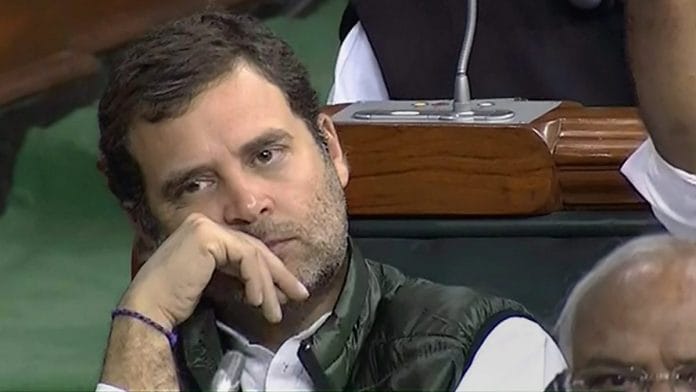The spectacular return of the BJP-led NDA has scripted a new chapter in India’s political history. For once, most exit polls were right in predicting the election outcome.
But then, the 2019 Lok Sabha results were not difficult to predict. Anyone who closely followed the events in the past few months knew which way the winds were blowing.
While the BJP came across as a serious player, the Congress gave an impression that it was a laid-back party with no leadership, no enthusiasm among the cadre and no alternate agenda.
The BJP’s 2019 victory is driven by a number of factors and strategies – the winners got them right while the losers had none to begin with.
Also read: 2019 will be known as the “Aayega To Modi Hi” election
Muscular policy against terrorism
India saw some major terrorist attacks on military establishments/forces in the last few years – Pathankot, Uri and Pulwama. Terrorism from across the border was not new, but Modi government’s response was.
It swung into action and carried out cross-border surgical strikes in September 2016, weeks after the Uri terror attack. This year, in the wake of the terror attack on a CRPF convoy in Pulwama, the IAF carried out air strikes on Balakot in Pakistan.
In this backdrop, the opposition’s criticism of Modi government’s muscular policy against terrorism and accusing it of corruption in a defence deal were foolish, to say the least.
The Congress failed to read the writing on the wall. It was naïve on the part of the Congress and rest of the opposition to expect the BJP to desist from claiming credit for taking on terrorism.
Taking it to the people
Modi’s surgical strike on corruption began with demonetisation, and structural corrections in economy continued with the introduction of GST. The Congress and other political adversaries of the BJP misread the public mood and miserably failed to provide an alternative economic policy or a positive narrative on development.
The BJP, in contrast, effectively conveyed to people the Modi government’s welfare programmes and how meticulously they were implemented.
Also read: Rahul Gandhi must decide if Congress is a European NGO or a party in nationalist India
A large section of rural women, youth and first-time voters, who were looking for a change, found a ready platform in the BJP and Modi’s leadership. The Congress leadership, on the other hand, focused only on non-existent corruption charges and ran a political campaign on unsubstantiated accusations.
Rahul no match for Modi
For the Congress leadership, a mere introspection is meaningless. The party needs a complete overhaul, from top to bottom, preferably from the top. While Rahul Gandhi’s leadership may not be questioned, the party will be wiped out if it fails to change the way it is being run now. A series of failures is too serious a matter to be left only to drawing-room debates.
It has been proven second time in a row that Rahul Gandhi is no match for Narendra Modi in strategy, in leadership, in political prowess – qualities that are needed to win a big election and lead a government at the Centre.
Rahul Gandhi also failed to stitch a formidable coalition; Congress could not project itself as an acceptable coalition partner, as seen in Uttar Pradesh.
The Congress needs a new narrative, a new orientation and above all a new leader, preferably not from the current ‘parivar’.
Lessons for regional parties
As far as regional parties are concerned, they should learn a lesson from this election results. Indian voters are discerning in their decision-making process, and can differentiate between regional and national issues. The BJP’s gains in Odisha and West Bengal show that voters here are ready to place their trust in a national party despite the presence of a strong regional player.
In Bengal, TMC supremo and chief minister Mamata Banerjee’s minority appeasement policies and aggressive campaigning have become counterproductive, and will eventually lead to her party’s fall in the next state election.
Regional parties should now start governing and stop dreaming about running the central government through proxy. In all likelihood, Karnataka, Tamil Nadu and West Bengal will witness massive political upheavals in the coming months, if not weeks.
Also read: Lesson for Rahul Gandhi in 2019: Mocking ‘Hinduness’ won’t work because India is Bharat
Challenges for new government
Modi’s 2019 election campaign began in May 2014 when he took over as the Prime Minister. He clearly listed his government’s foreign policy priorities by inviting heads of neighbouring states to his swearing-in ceremony. It signalled a fresh start and a renewed thrust to India’s geo-political ambitions in the region.
Soon, he began his fight against corruption. Then came a series of pro-poor initiatives. And finally, the extensive campaign by Modi-Shah dealt a crushing blow to the Congress and the shaky gathbandhan.
Modi’s second innings no doubt come with huge opportunities and challenges. The Indian economy needs greater integration with the changing dynamics in the global economy. The Make in India scheme, the policies to support ease of doing business, and the taxation structure need tweaking to generate more employment and growth. Social harmony and internal security should be the top priorities for the new government.
The author is former editor of ‘Organiser’. Views are personal.






